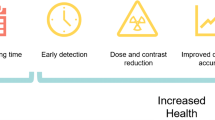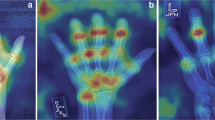Abstract
Predictions related to the impact of AI on radiology as a profession run the gamut from AI putting radiologists out of business to having no effect at all. The use of AI appears to show significant promise in ER triage in the present. We briefly discuss the emerging effectiveness of AI in the ER imaging setting by looking at some of the products approved by the FDA and finding their way into “practice.” The FDA approval process to date has focused on applications that affect patient triage and not necessarily ones that have the computer serve as the only or final reader. We describe a select group of applications to provide the reader with a sense of the current state of AI use in the ER setting to assess neurologic, pulmonary, and musculoskeletal trauma indications. In the process, we highlight the benefits of triage staging using AI, such as accelerating diagnosis and optimizing workflow, with few downsides. The ability to triage patients and take care of acute processes such as intracranial bleed, pneumothorax, and pulmonary embolism will largely benefit the health system, improving patient care and reducing costs. These capabilities are all available now. This first wave of AI applications is not replacing radiologists. Rather, the innovative software is improving throughput, contributing to the timeliness in which radiologists can get to read abnormal scans, and possibly enhances radiologists’ accuracy. As for what the future holds for the use of AI in radiology, only time will tell.

Similar content being viewed by others
References
Kulkarni S, Seneviratne N, Baig MS, Khan AHA (2020) Artificial intelligence in medicine: where are we now? Acad Radiol 27(1):62–70
Jha S, Cook T (2020) Artificial intelligence in radiology—the state of the future. Acad Radiol 27(1):1–2
Bryan RN, Davatzikos C, Herskovits EH, Mohan S, Rudie JD, Rauschecker AM (2020) Medical image analysis: human and machine. Acad Radiol 27(1):76–81
Allen B, Dreyer K, McGinty GD (2019) Integrating artificial intelligence into radiologic practice: a look to the future. J Am Coll Radiol
Tang A, Tam R, Cadrin-Chênevert A, Guest W, Chong J, Barfett J, Chepelev L, Cairns R, Mitchell JR, Cicero MD, Poudrette MG, Jaremko JL, Reinhold C, Gallix B, Gray B, Geis R, Canadian Association of Radiologists (CAR) Artificial Intelligence Working Group (2018) Canadian Association of Radiologists white paper on artificial intelligence in radiology. Can Assoc Radiol J 69(2):120–135
Shi J, Sahiner B, Chan HP, Hadjiiski L, Zhou C, Cascade PN, Bogot N, Kazerooni EA, Wu YT, Wei J (2007) Pulmonary nodule registration in serial CT scans based on rib anatomy and nodule template matching. Med Phys 34(4):1336–1347
Baker JA, Kornguth PJ, Lo JY, Williford ME, Floyd CE Jr (1995) Breast cancer: prediction with artificial neural network based on BI-RADS standardized lexicon. Radiology. 196(3):817–822
Maccioni F Israeli brain scan-reading AI-based software gets thumbs up from FDA, Time The Times of Israel October 15, 2018. https://www.timesofisrael.com/israeli-brain-scan-reading-ai-based-software-gets-thumbs-up-from-fda-time/. Accessed Aug 19 2019
Halon E. Zebra Medical wins FDA clearance for AI intracranial hemorrhage detection. The Jerusalem Post. June 17, 2019. https://www.jpost.com/HEALTH-SCIENCE/Zebra-Medical-wins-FDA-approval-for-AI-intracranial-hemorrhage-detection-592815. Accessed 19 Aug 2019
MaxQ AI receives FDA clearance for Accipio Ix intracranial hemorrhage platform. Imaging Technology News. November 7, 2018. https://www.itnonline.com/content/maxq-ai-receives-fda-clearance-accipio-ix-intracranial-hemorrhage-platform. Accessed 1/29/20
Brown D FDA clears AI detection software for diagnosing brain bleeds. AI in Healthcare. Nov. 8, 2018. https://www.aiin.healthcare/topics/diagnostics/fda-clears-ai-detection-software-brain-bleeds. Accessed 1/29/20
Department of Health and Human Services, US Food and Drug Administration. Indications for use, BriefCase. August 8. 2018
Aidoc receives FDA clearance for AI detection of acute intracranial hemorrhage. Imaging Technology News. August 8, 2018. https://www.itnonline.com/content/aidoc-receives-fda-clearance-ai-detection-acute-intracranial-hemorrhage. Accessed 2/3/20
Ojeda P, Zawaideh M, Mossa-Basha M, Haynor D The utility of deep learning: evaluation of a convolutional neural network for detection of intracranial bleeds on non-contrast head computed tomography studies. Proceedings Vol. 10949, Medical Imaging 2019: Image Processing, March 15, 2019, SPIE Medical Imaging, 2019, San Diego, CA, USA
Third FDA clearance announced for Zebra-Med’s AI solution for brain bleed alerts. Imaging Technology News. June 19, 2019. https://www.itnonline.com/content/third-fda-clearance-announced-zebra-meds-ai-solution-brain-bleed-alerts. Accessed 2/3/20
Ramos LA, van der Steen WE, Sales Barros R, Majoie CBLM, van den Berg R, Verbaan D, Vandertop WP, Zijlstra IJAJ, Zwinderman AH, Strijkers GJ, Olabarriaga SD, Marquering HA (2019) Machine learning improves prediction of delayed cerebral ischemia in patients subarachnoid hemorrhage. J Neurointerv Surg 11(5):497–502
Zhang Y, Zhang B, Liang F, Liang S, Zhang Y, Yan P, Ma C, Liu A, Guo F, Jiang C (2019) Radiomics features on non-contrast-enhanced CT scan can precisely classify AVM-related hematomas from other spontaneous intraparenchymal hematoma types. Eur Radiol 29(4):2157–2165
Chilamkurthy S, Ghosh R, Tanamala S et al (2018) Deep learning algorithms for detection of critical findings in head CT scans: a retrospective study. Lancet. 392(10162):2388–2396
Lee H, Yune S, Mansouri M, Kim M, Tajmir SH, Guerrier CE, Ebert SA, Pomerantz SR, Romero JM, Kamalian S, Gonzalez RG, Lev MH, Do S (2019) An explainable deep-learning algorithm for the detection of acute intracranial haemorrhage from small datasets. Nat Biomed Eng 3(3):173–182
Weikert TJ, Winkel DJ, Bremerich J, et al. AI-powered detection of pulmonary embolism in CT pulmonary angiograms: a validation study of the diagnostic performance of prototype algorithms. ECR Online. Abstract: https://ecronline.myesr.org/ecr2019/index.php?p=recorddetail&rid=139db6ef-260e-4d96-a1b4-3808434b7495&t=browsesessions#ipp-record-8210bd69-763b-4799-8f35-03de381ad49a. Accessed 8/16/2019
Taylor AG, Mielke C, Mongan J (2018 Nov 20) Automated detection of moderate and large pneumothorax on frontal chest X-rays using deep convolutional neural networks: a retrospective study. PLoS Med 15(11):e1002697
Walter M AI-powered triage solution for pneumothorax gains FDA clearance. Radiology Business. May 13, 2019. https://www.radiologybusiness.com/topics/artificial-intelligence/ai-triage-pneumothorax-fda-clearance-zebra-medical. Accessed 19 Aug 2019
Rosenfield S. FDA clears GE healthcare’s X-ray AI suite. Inside Digital Health, September, 12, 2019. https://www.idigitalhealth.com/news/fda-clears-ge-healthcares-xray-ai-suite. Accessed 1/9/2020
Harvey HB, Gowda V (2020) How the FDA regulates AI. Acad Radiol 27(1):58–61
Gan K, Xu D, Lin Y et al (2019) Artificial intelligence detection of distal radius fractures: a comparison between the convolutional neural network and professional assessments. Acta Orthop 3:1–12
Olczak J, Fahlberg N, Maki A, Razavian AS, Jilert A, Stark A, Sköldenberg O, Gordon M (2017) Artificial intelligence for analyzing orthopedic trauma radiographs. Acta Orthop 88(6):581–586
Lindsey R, Daluiski A, Chopra S et al (2018) Deep neural network improves fracture detection by clinicians. Proc Natl Acad Sci U S A 115(45):11591–11596
Kim DH, MacKinnon T (2018) Artificial intelligence in fracture detection: transfer learning from deep convolutional neural networks. Clin Radiol 73(5):439–445
Yaeger KA, Martini M, Yaniv G, Oermann EK, Costa AB (2019) United States regulatory approval of medical devices and software applications enhanced by AI. Health Pol Tech 8(2):192–197
Gottlieb S. Transforming FDA’s approach to digital health. US Food and Drug Administration. Speech, April 26, 2018. https://www.fda.gov/NewsEvents/Speeches/ucm605697.htm. Accessed 2/3/20
US Food and Drug Administration. Proposed regulatory framework for modifications to artificial intelligence/machine learning (AI/ML)-based software as a medical device (SaMD). Discussion Paper and Request for Feedback. https://www.fda.gov/media/122535/download. Accessed 2/3/20
Thrall JH, Li X, Li Q, Cruz C, Do S, Dreyer K, Brink J (2018) Artificial intelligence and machine learning in radiology: opportunities, challenges, pitfalls, and criteria for success. J Am Coll Radiol 15(3 Pt B):504–508
Mazurowski MA (2019) Artificial intelligence may cause a significant disruption to the radiology workforce. J Am Coll Radiol 16(8):1077–1082
Allen B, Dreyer K, McGinty GB (2020) Integrating artificial intelligence into radiologic practice: a look to the future. J Am Coll Radiol 17(2):280–283
Gong B, Nugent JP, Guest W, Parker W, Chang PJ, Khosa F, Nicolaou S (2019) Influence of artificial intelligence on Canadian medical students’ preference for radiology specialty: a national survey study. Acad Radiol 26(4):566–577
Mazurowski MA (2020) Artificial intelligence in radiology: some ethical considerations for radiologists and algorithm developers. Acad Radiol 27(1):127–129
Lam G, Fishman EK, Horton KM, Rowe SP (2019) Simplifying complexity: lessons for radiology from a new type of stock exchange. J Am Coll Radiol 16(4 Pt A):536–538
Author information
Authors and Affiliations
Corresponding author
Ethics declarations
Conflict of interest
The authors declare that they have no conflict of interest.
Additional information
The authors declare that they had full access to all of the data in this study and the authors take complete responsibility for the integrity of the data and the accuracy of the data analysis.
Publisher’s note
Springer Nature remains neutral with regard to jurisdictional claims in published maps and institutional affiliations.
Rights and permissions
About this article
Cite this article
Weisberg, E.M., Chu, L.C. & Fishman, E.K. The first use of artificial intelligence (AI) in the ER: triage not diagnosis. Emerg Radiol 27, 361–366 (2020). https://doi.org/10.1007/s10140-020-01773-6
Received:
Accepted:
Published:
Issue Date:
DOI: https://doi.org/10.1007/s10140-020-01773-6




